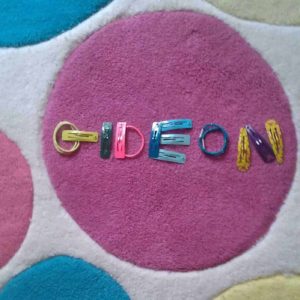It’s sometimes easy to feel that to do faith at home we need lots of resources and materials. I’m very into having specific items to do faith at-home activities. I love my Godly Play sets for sharing Bible stories and playing with them as we explore where we are in the stories. However, I believe that most of us have everything we need to get going, and as we go we can add the things we need. Once we get going, it’s easier to see what resources will really be most useful to us. So here are some of my ideas on how we can use what we already have at home to do faith at home.
1 Yourself!
This might sound scary or unrealistic, but I really believe that as parents we are the most potent resource in our homes for doing faith at home. Children are far more likely to do what they see us doing than what we tell them. We all absorb behaviours and attitudes from our parents, both good and bad, and repeat them in our adult lives unless we intentionally choose not to. This means we need to be what we want to see. Challenging, but essential.
2 Food
Food is a brilliant way to bring people together, and nowhere more so than in our home. Meals together are a fab place to share high and low-lights of our day and to pray, to share Bible stories together and chat about where we see ourselves in the story. Food comes into most Jewish rituals, a good example being Passover, and is obviously part of our sacred meal of bread and wine. All this lends itself to regular food times being spiritual occasions, times when we encounter Jesus at our table.
As well as this there are lots of fun ways we can use food to pray, such as using jelly babies or mini eggs and giving each colour sweet a category for prayer. This can be thanks, please or even chat prayers. This never seems to get old! There’s also a lot of scope for theming our food with Bible stories, such as fish fingers and the feeding of the 5000, or Jesus and coin in the fish’s mouth or one of the miraculous catches of fish. Lamb chops and sheep stories might be a step too far for you, but bread is an easy one to match with lots of passages.
3 Utensils
If using food isn’t your thing, or if you have young children, you could start with kitchen utensils. When my daughter was a baby, her favourite toy for a long while was a red washing-up brush from IKEA. I read books on Montesorri style of education, and so I created baskets for her of items from different rooms of the house, one week at a time. Even from a young baby, she could handle real items from the kitchen: wooden spoons, metal spoons, a ladle, a plastic spatula, a plastic mixing bowl, and of course the washing-up brush! As she got older, we bought a lovely set of mini plastic wine glasses from IKEA which she loved using to mimic ours. Any of these items could be used to share stories involving food: Abraham and Sarah and the three visitors, Passover, Elijah and the widow, Jesus with Mary and Martha, Mary anoints Jesus’ feet, Jesus’ last supper, Jesus appears to his friends and eats fish. Just set up a simple meal table, using a play table and chairs if possible.
Maybe lay a cloth (napkin?!) if you have one, and a few meal pieces. Then sit at the table and play ‘tea parties’ and share the story together. You could tell the story from memory or read it from a Bible. Playing the meal makes it easy to imagine together how it might have been to be there in the story. What did the different people say? Think? Do? What might have happened after that?
An Aside
The idea for this came after reading a blog post called 30 days to transform your play—day 16 – use real tools. In it, the author talks about how appealing REAL things are to children, and how the weight and design of real things rather than plastic versions are just so much nicer to work with. She suggests sometimes we need to provide child-sized tools to allow them to really do work, such as when baking or gardening, as the adult-sized tools, can be cumbersome and the children’s ones plastic and unsatisfactory. Ever tried cutting with blunt scissors?!
4 Gardening tools
What about gardening tools? Most young children I know will happily play with a watering can! You could even do this indoors, perhaps in the bath! But why stop there? Sowing seeds using small trowels is easy, fun and educational, as well as the perfect backdrop for numerous Bible stories about seeds and agriculture! Why not try this out with the story of Cain and Able or Jesus’ parables of the sower, the mustard seed or even the workers in the vineyard. And when your seeds are sown, you can use their regular watering to remind you to pray about something or for someone in particular.
5 Toys
If you’re a parent, there’s probably something you have more than enough it. Toys! I’m always reading articles about how to cull toys, but how about using them strategically to enhance spiritual play and faith development? I love using dressing up to do role play of Bible stories. There doesn’t seem to be much call for princesses, but with a simple pillow case with slits cut for a head and two arms, a simple ‘oldie worldie’ outfit it created. All you need are different kinds of belt, a shawl, or a headdress. We use lots of play cloths, as these can be used for dressing up as all sorts of things, as well as making dens, hammocks and anything else which happens to come into my childrens’ heads. These work well for creating all sorts of Bible story costumes. I’ve also cut a hole in the middle of a large white IKEA fleece throw, and it has become an angel costume! Telling the story and letting the actors act it is great fun!
Small world characters, and sets like Playmobil, Duplo and Lego can all be used to share Bible stories together, from the most well-known (Jesus and the man lowered through the roof) to the more obscure (King Josiah and the hidden scroll).
Do you have musical instruments? Real ones are fab to make soundtracks for Bible stories. The obvious stories to do are Jesus calms the storm or the walls of Jericho, but it’s possible with lots of stories to explore the emotional tone of the events.
6 Homemade toys
If you’re going to the bother of making toys, why not include some which could be used to do faith at home? We’ve developed a real tools doctors’ kit using real items such as a stethoscope (less than £3 on Ebay), bandages, tongue pressers, a notebook for the prescription pad, plasters and sprain bandages. I put them in a black bag with a white cross (painted on in Tippex!) and now it is the Doctor Kit which can be used in any Bible stories with a sick person. The doctor doesn’t have to be in the Bible story! But as you set up the scene with the character who is ill, the doctor can come and see them and establish there’s nothing they can do for them. This is fun and helps bring a contemporary link for children about God’s healing miracles.
7 Everything else!
One thing the author of the article suggested was that most items in our houses could be played with by children if given the chance. We don’t necessarily have to have worked out what they will do with them in advance. She gave the example of some plastic tubing they had which her son made into something. I think we have all seen what children do with cardboard boxes, so let’s be brave and give them opportunity to play with other things in our house and let them explore their theology or thinking about God as they do.
P.S. This picture is of a prayer using hair clips

